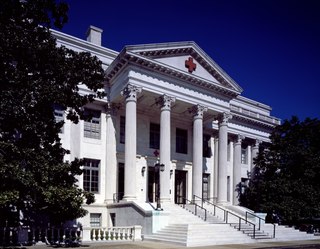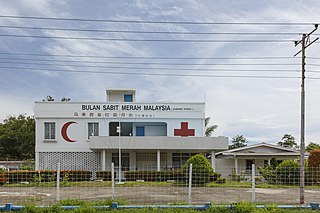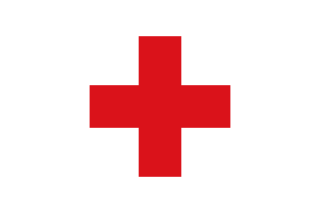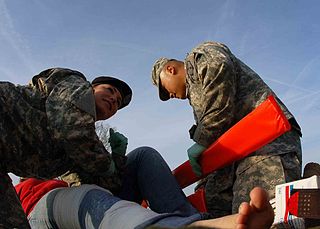
A disaster is an event that causes serious harm to people, buildings, economies, or the environment, and the affected community cannot handle it alone. Natural disasters like avalanches, floods, earthquakes, and wildfires are caused by natural hazards. Human-made disasters like oil spills, terrorist attacks and power outages are caused by people. Nowadays, it is hard to separate natural and human-made disasters because human actions can make natural disasters worse. Climate change also affects how often disasters due to extreme weather hazards happen.

The Magen David Adom is Israel's national emergency medical, disaster, ambulance and blood bank service. The literal meaning of name is "Red Shield of David," but the symbol is more frequently called the "Red Star of David" in many languages. Since June 2006, Magen David Adom has been officially recognized by the International Committee of the Red Cross (ICRC) as the national aid society of the State of Israel under the Geneva Conventions, and a member of the International Federation of Red Cross and Red Crescent Societies. MDA has a dedicated medical emergency phone number in Israel, 101. MDA can become an auxiliary arm of the Israel Defense Forces during times of war. In 2022, MDA became academically affiliated with Ben-Gurion University of the Negev. Following the October 7th attacks against Israel, the American Red Cross presented Magen David Adom with the International Humanitarian Service Award stating that the organization "exemplifies and inspires the humanitarian values of human dignity, respect, [and] compassion."

A certified first responder is a person who has completed a course and received certification in providing pre-hospital care for medical emergencies. Certified individuals should have received much more instruction than someone who is trained in basic first aid and cardiopulmonary resuscitation (CPR) but they are not necessarily a substitute for more advanced emergency medical care rendered by emergency medical technicians and paramedics. First responders typically provide advanced first aid level care, CPR, and automated external defibrillator (AED) usage. The term "certified first responder" is not to be confused with "first responder", which is a generic term referring to the first medically trained responder to arrive on scene and medically trained telecommunication operators who provide pre-arrival medical instructions as trained Emergency Medical Dispatchers (EMD). Many police officers and firefighters are required to receive training as certified first responders. Advanced medical care is typically provided by EMS, although some police officers and firefighters also train to become emergency medical technicians or paramedics.

Latter-day Saint Charities is a branch of the welfare department of the Church of Jesus Christ of Latter-day Saints. The organization's stated mission is to relieve suffering, to foster self-reliance for people of all nationalities and religions, and to provide opportunities for service.
The British Red Cross Society is the United Kingdom body of the worldwide neutral and impartial humanitarian network the International Red Cross and Red Crescent Movement. The society was formed in 1870, and is a registered charity with more than 17,200 volunteers and 3,400 staff. At the heart of their work is providing help to people in crisis, both in the UK and overseas. The Red Cross is committed to helping people without discrimination, regardless of their ethnic origin, nationality, political beliefs or religion. Queen Elizabeth II was the patron of the society until her death in 2022, and was replaced by her successor King Charles III, who previously served as president between 2003 and 2024.

Disaster response is the actions taken directly before, during or immediately after a disaster. The objective is to save lives, ensure health and safety and to meet the subsistence needs of the people affected. It includes warning and evacuation, search and rescue, providing immediate assistance, assessing damage, continuing assistance and the immediate restoration or construction of infrastructure. An example of this would be building provisional storm drains or diversion dams. Emergency response aims to provide immediate help to keep people alive, improve their health and support their morale. It can involve specific but limited aid, such as helping refugees with transport, temporary shelter, and food. Or it can involve establishing semi-permanent settlements in camps and other locations. It may also involve initial repairs to damage to infrastructure, or diverting it.

The disaster recovery response to Hurricane Katrina in late 2005 included U.S. federal government agencies such as the Federal Emergency Management Agency (FEMA), the United States Coast Guard (USCG), state and local-level agencies, federal and National Guard soldiers, non-governmental organizations, charities, and private individuals. Tens of thousands of volunteers and troops responded or were deployed to the disaster; most in the affected area but also throughout the U.S. at shelters set up in at least 19 states.

The American National Red Cross, is a nonprofit humanitarian organization that provides emergency assistance, disaster relief, and disaster preparedness education in the United States. It is the designated US affiliate of the International Federation of Red Cross and Red Crescent Societies and the United States movement to the International Red Cross and Red Crescent Movement.

The Malaysian Red Crescent (MRC) is a voluntary humanitarian organization that seeks to promote humanitarian values, as well as provide service and public education in disaster management, as well as healthcare in the community. It is part of the International Red Cross and Red Crescent Movement.
**Citizen Corps: Enhancing Community Preparedness and Response**

The Irish Red Cross Society is the National Red Cross Society for the Republic of Ireland. The society was formally established on 6 July 1939 under the Red Cross Act 1938. It is affiliated to the International Federation of Red Cross and Red Crescent Societies. The society is organised on a voluntary basis. In Ireland, its activities include mountain rescue, first aid education of the public, the provision of first aid and ambulance services at public events, as well as other community services for older people, carers, migrants and prisoners. Outside Ireland, the society provides relief and humanitarian services in response to natural disasters and in regions of conflict.

Humanity First is an international charity that provides disaster relief and long term development assistance to vulnerable communities in 52 countries across 6 continents. The organisation is run by volunteers with diverse skillsets across the world and has access to thousands of extra volunteers worldwide. Volunteer staff in all areas often pay their own expenses to support the international projects.

The Lebanese Red Cross (LRC) is a humanitarian organization and an auxiliary team to the medical service of the Lebanese Army. Its headquarters is in the Lebanese capital city of Beirut. Founded in 1945, the organization comprises a number of approximately 7,000 members/volunteers and 200 staff personnel. The society works with the International Federation and the ICRC, and on a bilateral basis with the Norwegian and the French Red Cross. The LRC also works with the relevant components of the Lebanese authorities, with UN agencies and NGOs.

Emergency Medical Responders (EMRs) are people who are specially trained to provide out-of-hospital care in medical emergencies, typically before the arrival of an ambulance. Specifically used, an emergency medical responder is an EMS certification level used to describe a level of EMS provider below that of an emergency medical technician and paramedic. However, the EMR is not intended to replace the roles of such providers and their wide range of specialties.

A mass casualty incident describes an incident in which emergency medical services resources, such as personnel and equipment, are overwhelmed by the number and severity of casualties. For example, an incident where a two-person crew is responding to a motor vehicle collision with three severely injured people could be considered a mass casualty incident. The general public more commonly recognizes events such as building collapses, train and bus collisions, plane crashes, earthquakes and other large-scale emergencies as mass casualty incidents. Events such as the Oklahoma City bombing in 1995, the September 11 attacks in 2001, and the Boston Marathon bombing in 2013 are well-publicized examples of mass casualty incidents. The most common types of MCIs are generally caused by terrorism, mass-transportation accidents, fires or natural disasters. A multiple casualty incident is one in which there are multiple casualties. The key difference from a mass casualty incident is that in a multiple casualty incident the resources available are sufficient to manage the needs of the victims. The issue of resource availability is therefore critical to the understanding of these concepts. One crosses over from a multiple to a mass casualty incident when resources are exceeded and the systems are overwhelmed.

The humanitarian responses by non-governmental organizations to the 2010 Haiti earthquake included many organisations, such as international, religious, and regionally based NGOs, which immediately pledged support in the aftermath of the 2010 Haiti earthquake. Besides a large multi-contingency contribution by national governments, NGOs contributed significantly to both on-the-ground rescue efforts and external solicitation of aid for the rescue efforts.
This article describes humanitarian responses from "for-profit" organizations, such as business corporations, following the January 12, 2010, earthquake in Haiti.

Joseph Orlando Prewitt Díaz is a retired psychologist who specialized in psychosocial theory. He received the APA International Humanitarian Award from American Psychological Association

Following the 2011 Tōhoku earthquake and tsunami, Japan received messages of condolence and offers of assistance from a range of international leaders. According to Japan's foreign ministry, 163 countries and regions, and 43 international organizations had offered assistance to Japan as of September 15, 2011. The magnitude of the earthquake was estimated at 9.1. This article is a list of charitable and humanitarian responses to the disaster from governments and non-governmental organizations. As of March 2012, donations to areas affected by the disaster totalled ¥520 billion and 930,000 people have assisted in disaster recovery efforts.

Red Paw Emergency Relief Team is a Philadelphia-based nonprofit emergency service dedicated to helping pets displaced by house fires and other residential disasters. Their goal is to reunite pets with their families once they have recovered and reduce the number of animals surrendered to shelters due to sudden hardship. The team works with local chapters of the American Red Cross, fire departments, and other disaster relief organizations to provide search and rescue, emergency transport, veterinary care, shelter and supplies for affected pets, at no cost to their owners.

















